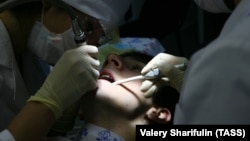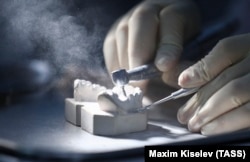Going to the dentist is never a welcome task, but for Russians living under sanctions imposed by the West on their country for its invasion of Ukraine, it’s now even harder to stomach.
The Russian dental industry is almost entirely dependent on European and U.S. imports of equipment and materials, and now, facing a virtually frozen supply chain, dentists are scrambling to weigh the alternatives of potentially inferior treatments for patients -- and having to raise prices.
“Getting one’s teeth treated has always been a luxury, and now even more so,” says Inna, the owner of a dental clinic in the Siberian city of Krasnoyarsk. “No matter how much you care for your patients, it’s impossible to keep the same prices.”
Inna says that every piece of dental equipment and material in her clinic is imported “without exception,” listing fillings, implants, prosthetics, crowns, and cement, among other essential items. Where previously these would have been ordered from European suppliers, many in Germany and Italy, now the supply chain has all but dried up. Any chance to get their gloved hands on the supplies that they have relied upon for so long now requires dentists to pay exorbitant prices, but in many instances simply isn’t possible.
Some dentists were able to stockpile supplies at the beginning of March before many Western sanctions came in. Inna’s clinic bought materials for the year ahead.
“If we hadn’t done this, I don’t even know what we would be doing now,” she says. “Now you can only buy quality materials if someone has some leftovers, and their prices on average are three times higher than before the war.”
She gives the example of an American filling material called Filtek, which in February cost 1,800 rubles ($33). “Now, you can’t find it for less than 4,300 ($79),” she says. “But the demand is still there.”
Other dentists point out that stockpiling can only go so far.
“Medical materials have a shelf life of about a year,” says Igor Rodin, an orthopedist, chief physician, and owner of a network of dental clinics in Tyumen. He says their supplies are now four times as expensive as they used to be. “First of all, the cost of consumables -- which are needed daily -- have risen. Paper is more expensive, as are aprons and saliva ejectors,” to name a few.
'We Can't Refuse Patients'
On the receiving end, patients are now finding themselves with unexpectedly steep bills. Lidia, a resident of Tyumen, says she’s been taking her son to an orthodontist in nearby Chelyuskintsev for several years.
“Previously, an initial appointment cost 700 rubles ($13), and a follow-up was 500 ($9),” she says. “Now they’re asking for 1,000 ($18) for the follow-up -- the prices have doubled.”
Inna says most patients she’s seen have been “sympathetic” about the price hikes, especially because her clinic stockpiled materials so was able to increase prices incrementally.
“Anesthesia at the beginning of the year cost 700 rubles ($13); now it’s 950 ($17.50). A root canal now costs 12,000 ($220) instead of the precrisis 8,000 ($147).”
“We understand that people no longer have money and for many it’s expensive, but what can we do? We cannot work at a loss,” she says.
The costliest service that dental clinics in Russia provide is arguably prosthetics, in particular implants. The field of implantology is fully dependent on imports and is now on the brink of going under.
“I have always preferred to work with German, Swedish, and American materials,” says Ilya Shumakov, an implantologist and orthopedic dentist from Novosibirsk. “Premium implants use titanium compounds, with minimal impurities.
"This isn’t something you can skimp on,” he adds, saying that now many materials have simply disappeared from the Russian market.
“Manufacturers don’t want to work with our state,” he says. “You can’t buy half of what you need.”
Rodin says his dental clinics fell into the red in the first quarter of 2022.
“The hardest part is insurance companies. They do annual contracts that state I cannot raise prices,” he says. “Today, we follow the 2020 price list of [Russian insurance company] SOGAZ. And we can’t refuse patients.”
He says they’ve had to resort to delaying patients.
“Yes, we started stretching them, saying everything is busy -- call back in a week. We play dirty, but SOGAZ also plays dirty.”
Russian Roulette, But Worse
Without the quality equipment and materials that both they and patients have come to rely on, dentists are cautiously looking for alternatives made in other countries. They are adamant, though, not to use domestic products, citing poor quality and little selection.
“We looked at what we could find in Russia. To be honest, there is no comparison with foreign materials,” says Inna of Krasnoyarsk. “We don’t want the client to return to us in a week, for example, with a filling that’s fallen out. We will lose more on this than we will earn.”
She says there was a level of trust and confidence in supplies from Europe and the United States that is lacking when it comes to Russian counterparts.
“With ours so far, it’s Russian roulette,” she says. “And not with one bullet in the drum but vice versa, when there's only one empty chamber.”
Suppliers in China have been eager to fill the gap in the Russian market. Inna says she’s had representatives write and call her directly, but she remains unsure.
“As a last resort, we’ll have to switch to China. They now have a unique position to occupy the Russian market. But there are doubts about whether we will benefit from this," she says. "The cost is comparable to European equipment, but we’ll have to see about the quality.”
Shumakov has also seen Chinese firms angling to replace importers that have pulled out.
“American 3M, for example, completely left Russia. Now the Chinese are trying to take their place,” he says. “We looked at the implants offered by China. It looks good on paper, but I don’t know what will happen in practice. And there’s no one to ask. Everyone else worked with imports from Europe or the United States, so they can’t give any advice about which is better.”
There are a handful of dental materials manufactured and available domestically, but the thought of using them is a Soviet “nightmare.”
“I know very well what quality it is,” says Shumakov. “Sometimes I’ve used our materials, but only for intermediate work. They are suitable for placing a temporary filling, but not a permanent one. Impression masses, cements, filling materials -- all this is not as good as it should be.”
And Russian anesthetics?
“No self-respecting dentist would use them. It’s a nightmare to switch back to lidocaine in big 5cc syringes with thick needles. I hope it doesn’t come to that,” Shumakov says.
For patients, too, the thought of returning to the poor-quality dental treatments of the Soviet era -- when dentists had limited choice of materials and lacked modern equipment and oversight -- is a terrifying prospect.
“I don’t want to reach the point where we have to use [Russian implants for my treatment],” says Olga Kerimova, a resident of Krasnoyarsk. "I still remember what Soviet dentistry is. I remember those yellow fillings and iron teeth. No thank you. I don’t want to return to the U.S.S.R.”
'Do Everything Now'
Regardless of prices, people who need a dentist cannot put off the treatment indefinitely. Inna encourages people to get their teeth examined before more serious problems arise -- and cost even more.
“Prices will continue to rise, so it’s better to do everything now,” she says. “People are not idiots. They know how to count, especially in a crisis. They know that a cavity will not go away on its own. If you don’t put a seal on it for 7,000 rubles, then you’ll have to treat the canals later for more than 12,000.”
Shumakov says that his clinic saw an influx of people in March who wanted to get their teeth treated for the old prices, and that even now, there’s no shortage of patients.
“I hope that the problems with supplies will be resolved, and we’ll have something to work with,” he says.






![A dental clinic in Russia's Omsk region. “No self-respecting dentist would use [Russian anesthetics]. It’s a nightmare to switch back to lidocaine in big 5cc syringes with thick needles. I hope it doesn’t come to that,” says Ilya Shumakov, a dentist from Novosibirsk. (file photo)](https://gdb.rferl.org/080a0000-0a00-0242-73f9-08da4ed1b8d7_w250_r0_s.jpg)





